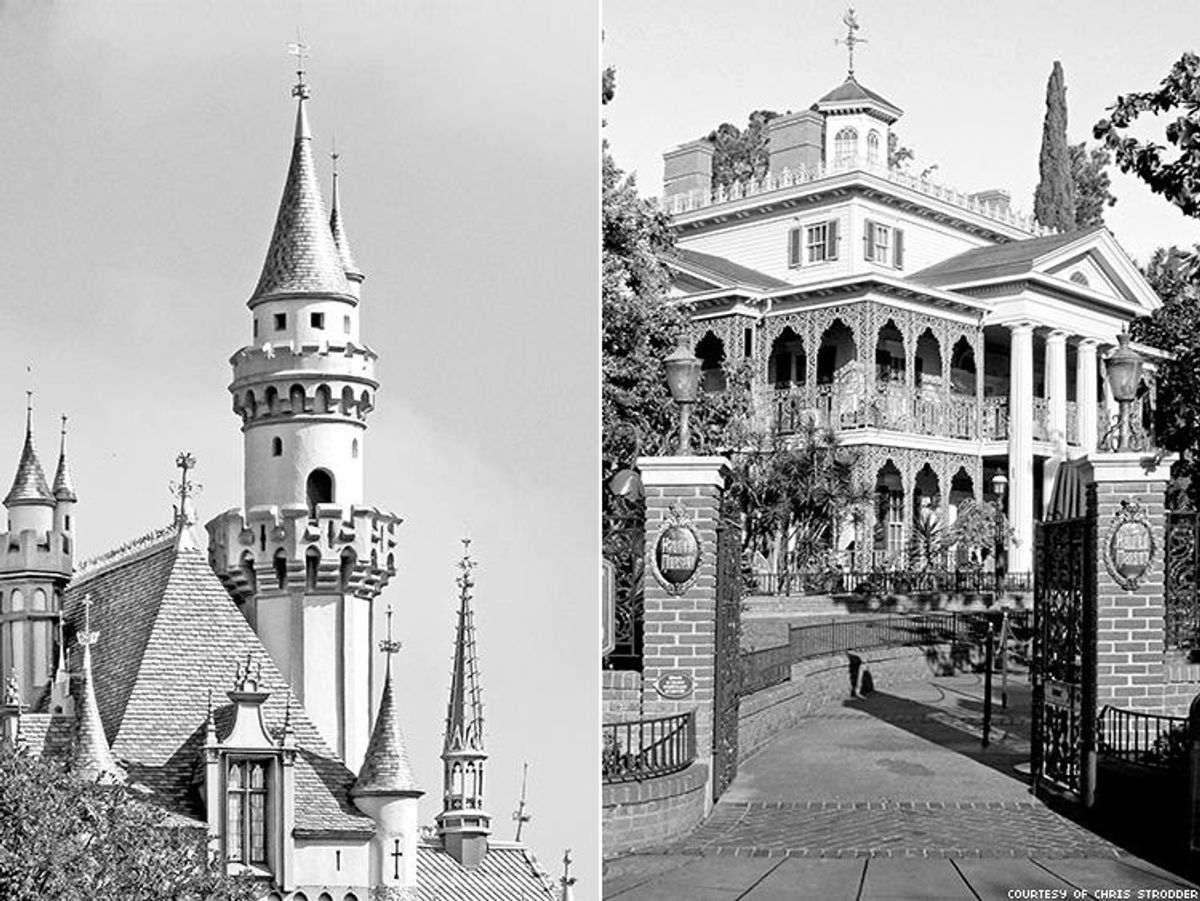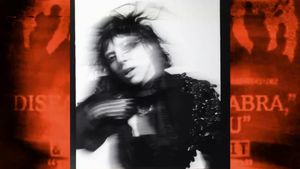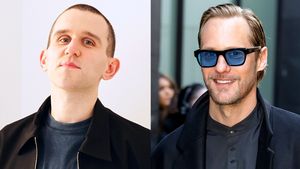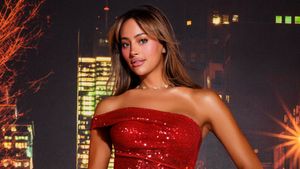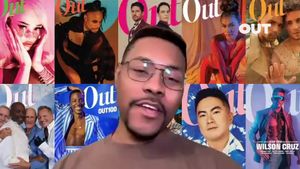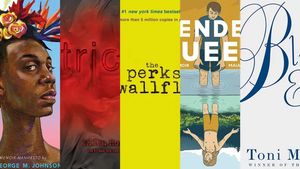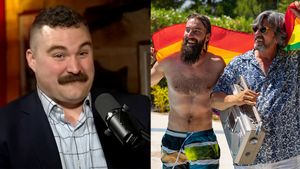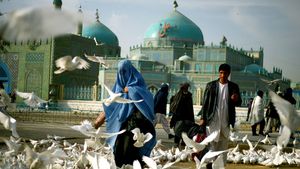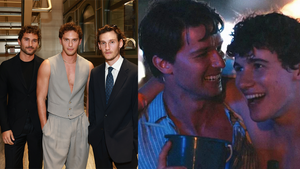From The Disneyland Encyclopedia by Chris Strodder, Santa Monica Press:
Apartments
MAP: Town Square, New Orleans Square
DATES: July 1955-ongoing; ca. 1970-1987
Walt Disney had a private apartment built above the Fire Department in Town Square so he and his family could have their own secluded nook at Disneyland. This apartment wasn't merely a VIP rest stop--it was an actual residence, a place where Disney and his family could stay overnight inside Disneyland, for days at a time if necessary.
Appropriately enough for this Disneyland neighborhood, the posh apartment was decorated like something out of the early 1900s. Emile Kuri, who decorated the sets for dozens of live-action Disney movies, brought in white columns, patterned wallpaper, red drapes, antique Victorian furniture, a working Victrola phonograph, and even an old-fashioned candlestick phone (a big, squat TV was one of the few conspicuous concessions to modern times). The apartment was small, though, just 500 square feet with a changing room, a cozy front room, where the couches unfolded into beds, a bathroom, and a tiny kitchen area with a grill, refrigerator, and sink. An outside lounge area stretching toward City Hall was decorated with white statues, plants, and wicker chairs.
In the Disney Parks: Disneyland Resort Behind the Scenes DVD, Disney Legend Martin Sklar says that the apartment "was a place where [Walt Disney] could be close to the action and yet be separated from it. I think Walt really wanted to be able to be close to what was happening here to understand it." From his front windows, Disney could look out on the bustling activity of Town Square, with the train station to his right, the Opera House straight across, and the Emporium to his left. The public wasn't allowed inside the private residence, of course, and in fact, the fire pole in the Fire Department below was blocked off to prevent anyone from shinnying up (supposedly Disney himself used to slide down the pole occasionally). Also, so that the residents upstairs wouldn't be disturbed by people ringing the bell downstairs, the outer doors of the Fire Department were usually closed when the apartment was occupied.
No mention of the apartment is made in Disneyland's early souvenir books, and no photos of the apartment were released until an exclusive shot of the Disney family relaxing in the main room ran in the August 1963 issue of National Geographic (the magazine dubs the apartment "Disney's supersecret hideaway"). One of the few times the general public has seen anyone in the apartment was Opening Day, when the TV broadcast of the festivities showed some people watching from the front window. Today, Walt Disney's relatives occasionally use the apartment, and it's sometimes included as a stop on special tours. As a tribute to Disney, a lamp, visible from Town Square, remains lit in the front window. During the holidays, a lighted Christmas tree sometimes fills the window as well.
In the 1960s, Disney decided that he needed a bigger apartment at the other end of Disneyland for both himself and his brother, Roy Disney. This 3,000-square foot residence would be located above the Pirates of the Caribbean entrance in New Orleans Square, with bedrooms for grandchildren and a balcony that connected to the private dining rooms at Club 33.
Walt Disney died before the second apartment was completed. It was used as offices for the Disneyland staff until 1987, when the whole space was converted into the Disney Gallery, with lavish decor to suggest what the finished rooms would have looked like. On the balcony outside the gallery's front door was an ornate iron railing with the initials of the apartment's intended occupants--WD and RD--woven into the design. In late 2007, the rooms were remodeled into a 2,600-square-foot Disneyland Dream Suite for the 2008 Disney Dreams Giveaway. Over five times larger than the tiny Town Square apartment, the new guest quarters include a patio with "fireflies," a living room with French Provincial decor, two master bedrooms, two bathrooms, an electric train, a full-size carousel horse, vintage toys, and unique audio and visual effects. In 2015, guests could win a night in the Dream Suite as one of the prizes in that year's special sweepstakes timed with Disneyland's Diamond Celebration.

Club 33
MAP: New Orleans Square
DATES: June 15, 1967-ongoing
One of Disneyland's worst-kept secrets is the presence of a private restaurant in New Orleans Square. The name Club 33 has long been the subject of speculation by fans, who have come up with a wide range of guesses--everything from 33 being the number of Disneyland sponsors to 33 somehow representing Mickey Mouse's initials (or Mickey Mouse's ears) when the digits are turned sideways. According to official explanations, the name is derived from the original address, 33 Royal Street, a number that's shown on what used to be the ground-level doorway next to the Blue Bayou.
There used to be another private dining room in the back of the Red Wagon Inn (now the Plaza Inn) on Main Street, but that one was much less elaborate than what now exists in New Orleans Square. Initially Club 33 was intended to be a quiet, luxurious private restaurant for VIP guests. It was built on the second story of the New Orleans Square buildings next to what was going to be Walt Disney's private apartment above Pirates of the Caribbean, but Disney passed away before the club and apartment were completed. When it was finished, Disneyland executives used Club 33 to entertain VIPs and business associates (the apartment next door was eventually opened as the Disney Gallery).
Within a few years, Club 33 had transformed from a private restaurant for Disney executives and their guests to a private club for a few hundred people who applied for entry, endured the waiting list, and paid the hefty membership fee. In 2007, Disneyland raised the number of members to 500, but new applicants could still expect to wait a decade for membership. By 2011, that membership cost over $10,000 per individual, plus over $3,500 a year in annual dues. In early 2012, Disneyland expanded its membership again to around 800 people and raised its fees to $25,000 for the initial membership, plus an additional $10,000 for annual dues. By mid-2014, the numbers were $35,000 initially and up to $14,000 annually. New membership does come with perks besides entrance into Club 33. Among the extras are park and admission, valet parking, VIP tours, and access to a new private lounge, 1901, opened in June 2012 inside Disney's California Adventure.
Club 33's interior, initially designed in part by Emile Kuri, is considered to be Disneyland's most fascinating dining space. For decades, members entered through Royal Street's Club 33 door and then took an elevator upstairs. Awaiting them were crystal chandeliers, artifacts from Disney movies, antiques purchased by Walt and Lillian Disney, and a gourmet buffet. The floor plan wrapped around the heart of New Orleans Square, from the Blue Bayou area to the spaces across Royal Street, above Cafe Orleans and the French Market. Two lavishly decorated dining rooms overlooked the Rivers of America. At one time, some kind of interactive Audio-Animatronics arrangement was going to be installed in the Trophy Room, and microphones were even placed inside chandeliers for instant communication between staff and guests. That plan however, never evolved past the experimental stage.
A major 2013 expansion resulted in the club shutting down for six months (members were offered alternate dining options during the closure). When it reopened, the restaurant had a new entrance through the room that used to be L'Ornement Magique, the interior space had doubled, and a new lounge (literally called La Salon Nouveau) had been added. Club 33 also got a new street address, though the number hasn't changed: according to Disneyland's tour guides, the club is now at 33 Orleans Street, not 33 Royal Street as it had been for almost five decades.
No sooner had this remodel concluded than another one began, with the goal of adding a new ultra-exclusive dining option to Disneyland. Named after its location, 21 Royal Street opened in September 2015 as a sophisticated, special-occasion restaurant that could be booked for small groups. With exquisite wall art and custom menus, 21 Royal Street offers the most elegant dining experience and charges the highest prices ($15,000 for a dozen people) in the park.
Besides its luxurious decor and magnificent views, Club 33 offers unique amenities that no other Disneyland restaurant does: it's the only one to serve alcohol; it indulges guests with gifts to remember their visit by; and it offers the impeccable service of Disneyland's most highly trained food servers.
Even as its secrets have been revealed over the years, Club 33 still retains its mystique. While many people have heard of it and even more have unknowingly walked right by the entrance or under its windows, only a very few will ever be able to say they've been inside.
Heliports
DATES: 1955-1972
Ever since the first freeways were built in the 1950s, people have been looking for ways to speed up their commutes. To shorten the travel time between his studio in Burbank and his park in Anaheim thirty-eight miles away, Walt Disney constructed his own heliport in 1955. This spartan landing pad was located outside Tomorrowland, beyond the southeast corner of Disneyland's berm; today's guests who walk in from Harbor Boulevard (with Space Mountain on their right) would be crossing the area where the first heliport was located. Los Angeles Airways soon introduced passenger service from Los Angeles International Airport to this spot, offering guests a scenic fifteen-minute flight back and forth between LAX and Disneyland. Early Fun Maps clearly show a whirlybird hovering over this southeastern heliport, and Disneyland's 1956 souvenir book boasts that "five helicopter flights arrive daily."
Five years later, a second heliport was built, this time beyond the western bern. This pad was located across West Street (aka Disneyland Drive) and just north of the burgeoning Disneyland Hotel. Once they'd landed, passengers took trams to the hotel. These flights by Los Angeles Airways were so popular that by decade's end, they had brought a million guests to Disneyland's doorstep. Tragically, two fata crashes in 1968 (killing forty-four people) brought the service to a halt. Los Angeles Airways briefly tried to revive the flights but was unsuccessful; Golden West Airlines launched a new helicopter service to this heliport in 1972, but canceled it after five months.
